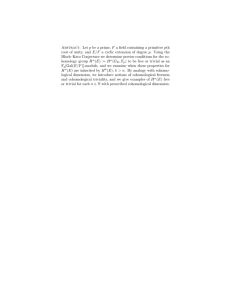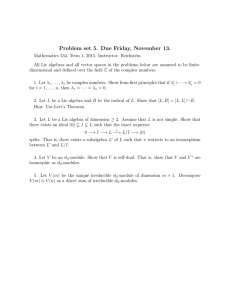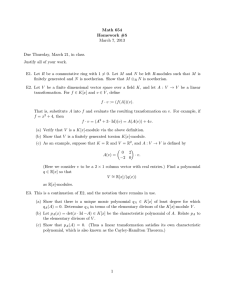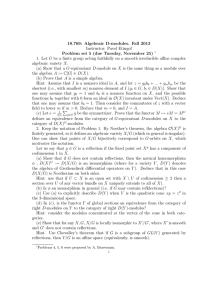ON THE COHOMOLOGICAL DIMENSION OF THE LOCALIZATION FUNCTOR Henryk Hecht, Dragan Miliˇ ci´
advertisement
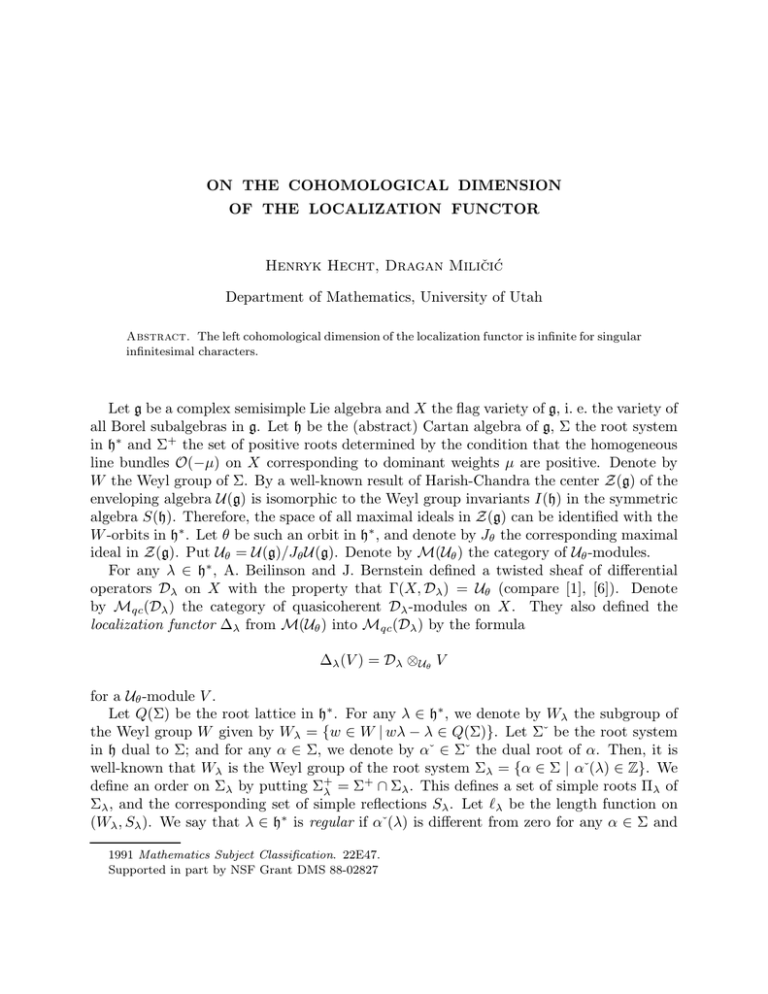
ON THE COHOMOLOGICAL DIMENSION
OF THE LOCALIZATION FUNCTOR
Henryk Hecht, Dragan Miličić
Department of Mathematics, University of Utah
Abstract. The left cohomological dimension of the localization functor is infinite for singular
infinitesimal characters.
Let g be a complex semisimple Lie algebra and X the flag variety of g, i. e. the variety of
all Borel subalgebras in g. Let h be the (abstract) Cartan algebra of g, Σ the root system
in h∗ and Σ+ the set of positive roots determined by the condition that the homogeneous
line bundles O(−µ) on X corresponding to dominant weights µ are positive. Denote by
W the Weyl group of Σ. By a well-known result of Harish-Chandra the center Z(g) of the
enveloping algebra U(g) is isomorphic to the Weyl group invariants I(h) in the symmetric
algebra S(h). Therefore, the space of all maximal ideals in Z(g) can be identified with the
W -orbits in h∗ . Let θ be such an orbit in h∗ , and denote by Jθ the corresponding maximal
ideal in Z(g). Put Uθ = U(g)/Jθ U(g). Denote by M(Uθ ) the category of Uθ -modules.
For any λ ∈ h∗ , A. Beilinson and J. Bernstein defined a twisted sheaf of differential
operators Dλ on X with the property that Γ(X, Dλ ) = Uθ (compare [1], [6]). Denote
by Mqc (Dλ ) the category of quasicoherent Dλ -modules on X. They also defined the
localization functor ∆λ from M(Uθ ) into Mqc (Dλ ) by the formula
∆λ (V ) = Dλ ⊗Uθ V
for a Uθ -module V .
Let Q(Σ) be the root lattice in h∗ . For any λ ∈ h∗ , we denote by Wλ the subgroup of
the Weyl group W given by Wλ = {w ∈ W | wλ − λ ∈ Q(Σ)}. Let Σˇ be the root system
in h dual to Σ; and for any α ∈ Σ, we denote by αˇ ∈ Σˇ the dual root of α. Then, it is
well-known that Wλ is the Weyl group of the root system Σλ = {α ∈ Σ | αˇ(λ) ∈ Z}. We
+
define an order on Σλ by putting Σ+
λ = Σ ∩ Σλ . This defines a set of simple roots Πλ of
Σλ , and the corresponding set of simple reflections Sλ . Let ℓλ be the length function on
(Wλ , Sλ ). We say that λ ∈ h∗ is regular if αˇ(λ) is different from zero for any α ∈ Σ and
1991 Mathematics Subject Classification. 22E47.
Supported in part by NSF Grant DMS 88-02827
2
HENRYK HECHT, DRAGAN MILIČIĆ
that λ is antidominant if αˇ(λ) is not a strictly positive integer for any α ∈ Σ+ . We put
n(λ) = min{ℓλ (w) | w ∈ Wλ , wλ is antidominant}. Beilinson and Bernstein proved that,
for regular λ, the left cohomological dimension of the localization functor is ≤ n(λ) ([2],
[8]). In this note we prove the following complementary result.
Theorem. Let λ ∈ h∗ be singular. Then the left cohomological dimension of the localization functor ∆λ is infinite.
Using the fact that the localization functor is an equivalence of the category M(Uθ ) with
the category Mqc (Dλ ) for regular antidominant λ, Beilinson and Bernstein also proved that
the homological dimension of Uθ is ≤ 21 (Card(Σ)+Card(Σλ )) if θ = W ·λ consists of regular
elements (unpublished, compare [8]). On the contrary, our result immediately implies the
following consequence.
Corollary. If θ consists of singular elements in h∗ , the homological dimension of Uθ is
infinite.
This fact was observed earlier by A. Joseph and J. T. Stafford ([7], 4.20). Our argument
shows that this is a simple consequence of the analogous behavior of homological dimension
for local rings.
Proof of the theorem. Let x be a point in X and denote by bx the corresponding Borel
subalgebra of g. Let nx = [bx , bx ] be its nilpotent radical. Let hx = bx /nx . Then hx is
canonically isomorphic to h [6]. Let c be a Cartan subalgebra of g contained in bx . Then
the composition of the projection c −
→ hx with this map gives an isomorphism of c onto h.
The inverse map is called a specialization at x. For a U(g)-module V , we put
Vnx = V /nx V = C ⊗U(nx ) V,
where we view C as a module with the trivial action of bx . It has a natural structure
of an hx -module. Therefore, we can view it as an h-module. It follows that V −→ Vnx
is a right exact covariant functor from the category of U(g)-modules into the category
of U(h)-modules. If we compose it with the forgetful functor into the category of vector
spaces, we get the functor H0 (nx , −) of zeroth nx -homology. By the Poincaré-BirkhoffWitt theorem, free U(g)-modules are also U(nx )-free, what implies the equality for the left
derived functors. Therefore, with some abuse of language, we view the (−p)th left derived
x)
functor of V −→ Vnx as the pth nx -homology functor Hp (nx , −) = TorU(n
(C, −).
p
We need a technical result, which must be well-known, but we were unable to find a
reference.
1. Lemma. Uθ is free as U(nx )-module.
Proof. Let c be a Cartan subalgebra of g contained in bx . This determines a specialization
of h to c and a nilpotent subalgebra n̄ opposite to nx . Then we have g = nx ⊕ c ⊕ n̄ and
U(g) = U(nx ) ⊗C U(c) ⊗C U(n̄) as a left U(nx )-module for left multiplication. Let Fp U(c),
ON THE COHOMOLOGICAL DIMENSION OF THE LOCALIZATION FUNCTOR
3
p ∈ Z+ , be the degree filtration of U(c). Then we define a filtration Fp U(g), p ∈ Z+ , of
U(g) via
Fp U(g) = U(nx ) ⊗C Fp U(c) ⊗C U(n̄).
This is clearly a U(nx )-module filtration. The corresponding graded module is
Gr U(g) = U(nx ) ⊗C S(c) ⊗C U(n̄).
This filtration induces a filtration on the submodule Jθ U(g) and the quotient module Uθ .
The Harish-Chandra homomorphism γ : Z(g) −→ U(h) is compatible with the degree
filtrations and the homomorphism Gr γ is an isomorphism of Gr Z(g) onto the subalgebra
I(h) of all W -invariants in S(h) ([4], Ch. VIII, §8, no. 5). Denote by I+ (h) the homogeneous
ideal spanned by the elements of strictly positive degree in I(h). Then
Gr Jθ U(g) = U(nx ) ⊗C I+ (c)S(c) ⊗C U(n̄).
It follows that
Gr Uθ = (Gr U(g))/(Gr Jθ U(g))
= (U(nx ) ⊗C S(c) ⊗C U(n̄))/(U(nx ) ⊗C I+ (c)S(c) ⊗C U(n̄))
= U(nx ) ⊗C (S(c)/(I+ (c)S(c))) ⊗C U(n̄),
i. e. it is a free U(nx )-module. Moreover, by ([4], Ch. V, §5, no. 2, Th. 1) we know that
the dimension of the complex vector space S(h)/(I+ (h)S(h)) is Card W . It follows that
Uθ has a finite filtration by U(nx )-submodules such that Gr Uθ is a free U(nx )-module. By
induction in length, this implies that Uθ is a free U(nx )-module. Let ρ be the half-sum of roots in Σ+ . Denote by ϕ : U(h) −→ U(h) the automorphism
given by ϕ(ξ) = ξ + ρ(ξ) for ξ ∈ h. Then, ϕ(γ(Z(g))) is the algebra of W -invariants in
U(h). In addition, as we remarked in the preceding proof, the dimension of the vector
space U(h)/ϕ(γ(Jθ ))U(h) is equal to Card W . This implies that Vθ = U(h)/γ(Jθ )U(h) is
an U(h)-module of dimension dimC Vθ = Card W .
For µ ∈ h∗ , we denote by Iµ the corresponding maximal ideal in U(h).
2. Lemma. Let λ ∈ h∗ and θ = W · λ. Then:
(i) Vθ is a U(h)-module of dimension dimC Vθ = Card W ,
(ii) the characteristic polynomial of the action of ξ ∈ h on Vθ is
P (ξ) =
Y
(ξ − (wλ + ρ)(ξ));
w∈W
(iii) H0 (nx , Uθ ) is a direct sum of countably many copies of Vθ .
Proof. We already established (i). Clearly, Iµ ⊃ ϕ(γ(Jθ ))U(h) is equivalent to µ = wλ
for some w ∈ W . Hence the linear transformation of U(h)/ϕ(γ(Jθ ))U(h) induced by
4
HENRYK HECHT, DRAGAN MILIČIĆ
multiplication by ξ has eigenvalues (wλ)(ξ), w ∈ W , and by symmetry they all have the
same multiplicity. This in turn implies that
ϕ(P (ξ)) =
Y
Y
ϕ(ξ − (wλ + ρ)(ξ)) =
w∈W
(ξ − (wλ)(ξ))
w∈W
is the characteristic polynomial for the action of ξ on U(h)/ϕ(γ(Jθ )) U(h). This proves (ii).
(iii) As in the proof of 1, we fix a specialization c of h and choose a nilpotent subalgebra
n̄ opposite to nx . By Poincaré-Birkhoff-Witt theorem, it follows that as a vector space
U(g) = U(nx ) ⊗C U(c) ⊗C U(n̄). Moreover,
H0 (nx , Uθ ) = U(g)/(Jθ U(g) + nx U(g)).
Denote by γx : Z(g) −
→ U(c) the composition of the specialization map with the HarishChandra homomorphism γ. Then
Jθ U(g) + nx U(g) = Jθ U(c) U(n̄) + nx U(g) = γx (Jθ ) U(c) U(n̄) + nx U(g),
which implies that under the above isomorphism
Jθ U(g) + nx U(g) = C ⊗C γx (Jθ ) U(c) ⊗C U(n̄) ⊕ nx U(nx ) ⊗C U(c) ⊗C U(n̄) .
This yields
H0 (nx , Uθ ) = U(c)/(γx(Jθ ) U(c)) ⊗C U(n̄) = Vθ ⊗C U(n̄)
and the action of h is given by multiplication in the first factor.
Therefore, maximal ideals in the ring Vθ are the images of the maximal ideals Iwλ+ρ ,
w ∈ W , in U(h), under the quotient map U(h) −
→ Vθ .
Let W (λ) be the stabilizer of λ in W . Denote by Rwλ the localization of Vθ at Iwλ+ρ .
Then, by ([3], Ch. IV, §2, no. 5, Cor. 1 of Prop. 9), we have
Vθ =
Y
Rwλ .
w∈W/W (λ)
Since the local rings Rwλ are finite-dimensional, they are regular if and only if dimC Rwλ =
1. Because of the Weyl group symmetry these rings are isomorphic, hence dimC Rwλ =
Card W (λ) for any w ∈ W . This finally leads to the following critical observation.
3. Corollary. The following conditions are equivalent:
(i) λ is regular;
(ii) the rings Rwλ , w ∈ W , are regular local rings.
By 1, we can calculate nx -homology of V using a left resolution of V by free Uθ -modules.
Therefore, we can view Hp (nx , V ) as Vθ -modules. Also, for any λ ∈ θ, Cλ+ρ = U(h)/Iλ+ρ
is a Vθ -module.
ON THE COHOMOLOGICAL DIMENSION OF THE LOCALIZATION FUNCTOR
5
For any OX -module F on X we denote by Tx (F ) its geometric fibre at x, i. e. Tx (F ) =
C ⊗Ox Fx , where Ox is the local ring of X at x. Since X is a smooth algebraic variety, Ox
is a regular local ring. Hence, the left cohomological dimension of the right exact functor
Tx is ≤ dim X.
For any abelian category A, denote by D− (A) the derived category of A-complexes
bounded from above, and by D the natural imbedding of A into D− (A) which maps an
object V of A into the complex D(V ) such that D(V )p = 0 for p 6= 0 and D(V )0 = V .
Since the localization functor ∆λ is right exact, it defines the left derived functor L∆λ
from D− (Uθ ) into D− (Dλ ). Analogously, Tx defines the left derived functor LTx from
D− (Dλ ) into the derived category D− (C) of complexes of complex vector spaces bounded
from above.
4. Proposition. Let λ ∈ h∗ , θ = W · λ and x ∈ X. Then the functors LTx ◦ L∆λ and
L
L
D(Cλ+ρ )⊗Vθ (D(C)⊗U(nx ) −) from D− (Uθ ) into D− (C) are isomorphic.
Proof. By 1, we know that Uθ is acyclic for the functor H0 (nx , −) = C ⊗U(nx ) −. By 2, we
also know that C ⊗U(nx ) Uθ is acyclic for the functor Cλ+ρ ⊗Vθ −. Let F · be a complex
isomorphic to V · consisting of free Uθ -modules. Then, since the functors commute with
infinite direct sums, we get
L
L
D(Cλ+ρ )⊗Vθ (D(C)⊗U(nx ) V · ) = Cλ+ρ ⊗Vθ (C ⊗U(nx ) F · ).
On the other hand, the localization ∆λ (Uθ ) = Dλ is a locally free OX -module, and therefore
acyclic for Tx . This implies that
LTx (L∆λ (V · )) = Tx (∆λ (F · )).
Hence, to complete the proof it is enough to establish the following identity
Tx (∆λ (Uθ )) = Cλ+ρ ⊗Vθ (C ⊗U(nx ) Uθ ).
First, we have Tx (∆λ (Uθ )) = Tx (Dλ ). Moreover, from the construction of Dλ ([1], [6]) and
the properties of the Harish-Chandra homomorphism, it follows that
Tx (Dλ ) = (U(g)/nx U(g))/(Iλ+ρ (U(g)/nx U(g)))
= Cλ+ρ ⊗Vθ (U(g)/nx U(g))/(γ(Jθ )(U(g)/nx U(g)))
= Cλ+ρ ⊗Vθ (U(g)/(Jθ U(g) + nx U(g))) = Cλ+ρ ⊗Vθ H0 (nx , Uθ ). 5. Remark. Using spectral sequences instead of derived categories, 4. implies the following
statement: The Grothendieck spectral sequences for composition of derived functors with
p,q
θ
E2 -terms E2p,q = Lp Tx (Lq ∆λ (V )) and E ′ 2 = TorV−p
(Cλ+ρ , H−q (nx , V )) converge to the
same limit.
To prove the theorem it is enough to establish the following fact.
6
HENRYK HECHT, DRAGAN MILIČIĆ
6. Lemma. Let λ ∈ h∗ be singular. Then there exists V ∈ M(Uθ ) such that L∆λ (D(V ))
is not a cohomologically bounded complex.
Proof. Since the functor Tx has finite left cohomological dimension, it is enough to find a
Uθ -module V such that LTx (L∆λ (V )) is not a bounded complex for some x ∈ X. By 4,
L
L
this is equivalent to the fact that D(Cλ+ρ )⊗Vθ (D(C)⊗U(nx ) D(V )) is not a cohomologically
bounded complex.
Let w0 be the longest element in W . Fix a Borel subalgebra b0 , and consider the
Verma module M (w0 λ) = U(g) ⊗U(b0 ) Cw0 λ−ρ . Pick x so that bx is opposite to b0 . Then,
by Poincaré-Birkhoff-Witt theorem, M (w0 λ) is isomorphic to U(nx ) ⊗C Cw0 λ−ρ as U(nx )module. This implies, since bx is opposite to b0 and corresponding specializations differ
by w0 , that
H0 (nx , M (w0 λ)) = Cλ+ρ ,
and Hp (nx , M (w0 λ)) = 0 for p ∈ N. Therefore,
L
D(C)⊗U(nx ) D(M (w0 λ)) = D(Cλ+ρ ),
and
L
L
L
D(Cλ+ρ )⊗Vθ (D(C)⊗U(nx ) D(M (w0 λ))) = D(Cλ+ρ )⊗Vθ D(Cλ+ρ ).
Clearly, we have
L
H −p (D(Cλ+ρ )⊗Vθ D(Cλ+ρ )) = TorVp θ (Cλ+ρ , Cλ+ρ ), p ∈ Z+ .
On the other hand, we have
λ
TorVp θ (Cλ+ρ , Cλ+ρ ) = TorR
p (C, C), p ∈ Z+ .
Since Rλ is not a regular local ring by 3, its homological dimension is infinite ([5], 17.3.1)
λ
and TorR
p (C, C) 6= 0 for p ∈ Z+ ([5], 17.2.11). This completes the proof of the theorem.
References
1. A. Beilinson, J. Bernstein, Localisation de g-modules, C. R. Acad. Sci. Paris, Ser. I 292 (1981), 15–18.
2. A. Beilinson, J. Bernstein, A generalization of Casselman’s submodule theorem, Representation Theory
of Reductive Groups, Birkhäuser, Boston, 1983, pp. 35–52.
3. N. Bourbaki, Algèbre commutative, Masson, Paris.
4. N. Bourbaki, Groupes et algèbres de Lie, Masson, Paris.
5. A. Grothendieck, Eléments de Géométrie Algébrique IV, Publ. I.H.E.S. No. 20 (1964).
6. H. Hecht, D. Miličić, W. Schmid, J. A. Wolf, Localization and standard modules for real semisimple
Lie groups I: The duality theorem, Inventiones Math. 90 (1987), 297–332.
7. A. Joseph, J. T. Stafford, Modules of k-finite vectors over semi-simple Lie algebras, Proc. London
Math. Soc. 49 (1984), 361–384.
8. D. Miličić, Localization and representation theory of reductive Lie groups, (mimeographed notes), to
appear.
Department of Mathematics, University of Utah, Salt Lake City, UT 84112

